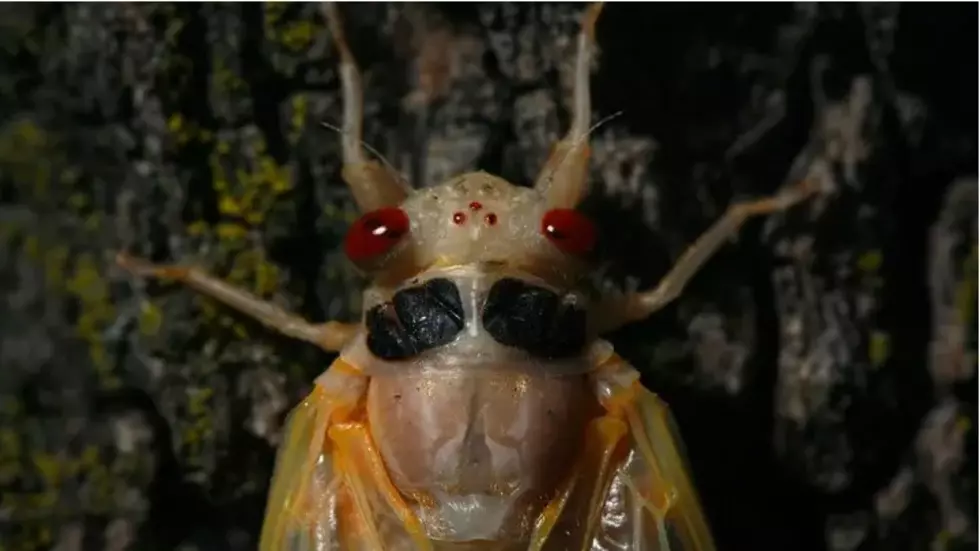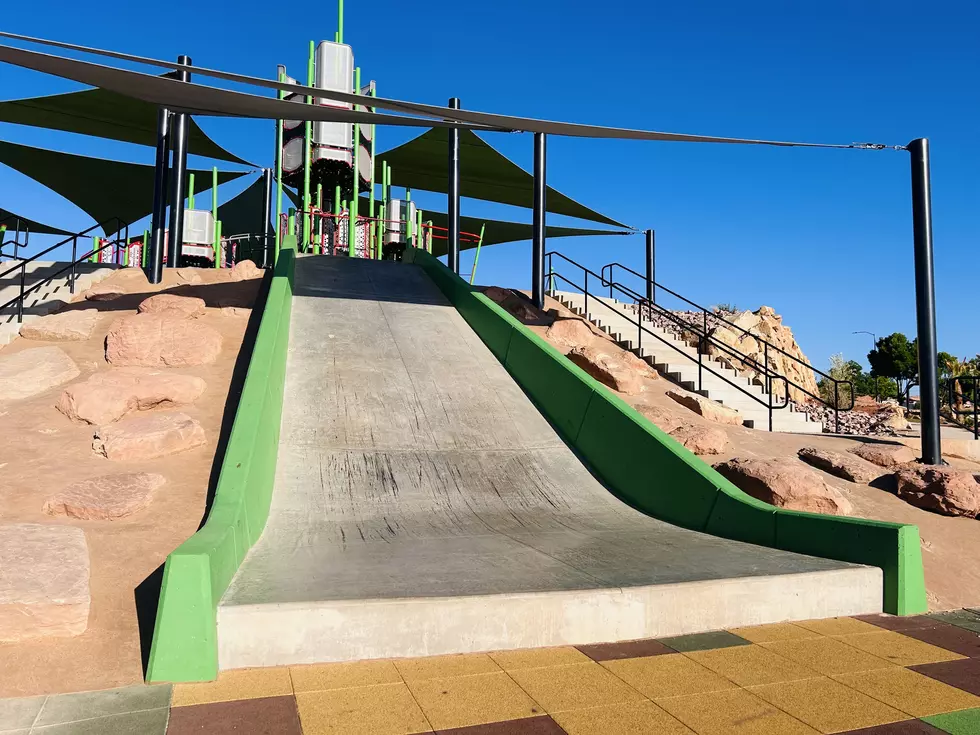
‘Bugpocalypse': Trillion Cicadas Emerging In 17 States — Is Utah One Of Them?
Everyone's talking about the cicada invasion coming to America soon.
Here's the story: Nearly a trillion cicadas will be hatching and invading the United States.with what some scientists are calling "Bug-pocalypse" this month.
Two different types of cicadas will be hatching at the same time -- brood XIX and brood XIII -- and this hasn't happened in more than 200 years.
The eggs will hatch and the bugs will emerge from the underground in 17 U.S. states in April in a rare natural phenomenon not seen since 1803.
Wait, 17 states? So is Utah one of them?
The simple answer is no.
But considering this phenomenon hasn't happened since 1803, when the West was far from won, no one can say for sure.
If you've never been around cicadas, which mainly live in the East and Southeast, they are noisy, ugly bugs usually around an inch long (or longer) that fly, but do not bite (think flying, buzzing cockroach).
According to UConn cicada expert John Cooley, "Cicadas can be dangerous to young trees as they lay their eggs in small tree branches which can harm the tree,"
The EPA advises covering maturing saplings in mesh or netting to keep the insects out.
Cicada's often molt or shed their outer skin and leave the crispy, hideous shell behind. Anyone who has ever found an empty cicada shell knows it's not a pretty sight.
A map put out by the US Forest Service shows that cicadas are not likely to make it further West than Texas and Oklahoma, but experts say anything can happen.
So if you hear a loud buzzing coming from a tree, but don't see anything, it's possible a cicada made it out to where you are.

Flipper Zero: Utahns Wary Of New Electronic Device That Can Hack Garage Door Openers
Have you heard of the Flipper Zero?
Until today, I hadn't either. But the new, cheap hacker device has got police, school administrators and other officials on high alert.
The makers of Flipper Zero, Flipper Devices, Inc., describe their handheld hacker toy as "a portable multi-tool for pentesters and geeks in a toy-like body. It loves hacking digital stuff, such as radio protocols, access control systems, hardware, and more. It's fully open-source and customizable, so you can extend it in whatever way you like."
Recently, in a story published on KSL.com, a Moab high school student used a Flipper Zero to disrupt electronics in a classroom for more than a week.
Larger concerns center around the device's ability to hack garage door codes, stoplights and even car doors. So what is true and what is myth with a Flipper Zero?
First, the things a Flipper Zero CAN do:
- Record and replicate garage door codes
- Record and replicate keycards, like the ones they use at hospitals and big businesses
- Read and record your credit card, although getting the CVC number on the other side of the card is still usually required for purchases. The FZ can't do that.
- Hack/crash someone's phone, although Apple recently put out an update to try and prevent this.
- Be programmed to play video games and change the channel on a TV.
Now the things a Flipper Zero CANNOT do (yet):
- Steal a car's keycode to open doors, start the ignition
- Steal from an ATM
- Get into a hotel room
- Change gas prices
- Change the scoreboard at a sporting event
Thanks to Lifehacker for some of this information.
Given that most of its nefarious uses are just myth, even criminals would be hard-pressed to justify buying one of these. They cost $170.

Save Your Own Life With Wednesday's National Walking Day
Years ago (in 2005 to be exact), Dr. David Sabgir, a cardiologist in Columbus, Ohio, was extremely frustrated with his inability to affect behavior change in the clinical setting.
You see, Dr. Sabgir often counseled his heart patients to get exercise -- go for a walk, lift weights, ride a bike, do aerobics -- something to help their hearts and bodies to better handle the modern day stresses.
But after years of being ignored, Dr. Sabgir decided advice was not enough.
He invited his patients to go for a walk with him in a local park on a spring Saturday morning. To his surprise, over 100 people showed up, energized and ready to move.
That was the start of the Walk With A Doc program, which has chapters all over the country now. And the marriage of "Walk With A Doc" and the celebration of this Wednesday's National Walking Day has turned into a perfect time to get people living a mostly sedentary lifestyle to get out and move.
The first Wednesday of April every year is National Walking Day. The American Heart Association sponsors this day to remind people about the health benefits of taking a walk. Wear your sneakers (or take them with you) to work, and at some point in the day, take a 30-minute walk.
The AHA offers these reasons why taking a walk can be beneficial to you:
- Improved cardiovascular health
- Maintaining a healthy weight
- Improved flexibility in joints
- Stronger muscles
- Improved mental health
And AHA also offers this advice on this day:
- Wear comfortable clothes.
- Take a friend to pass the time.
- Make sure to stretch those muscles.
- Drink plenty of water.
- Move your arms, too.
- Make sure you have good posture.
Marianne Hamilton, a St. George resident who just passed on her Ms. Senior Universe crown to a new winner, offers this advice:
"There are huge benefits, both physically and mentally," she said. "The physical side is pretty obvious, but the mental side is just as important."
From the New York Times:
For people in their 60s, regular walking appears to lower the risk of dementia. The finding, published in the medical journal Neurology, is the latest study to show that exercise helps delay some of the worst ravages of aging for both the body and the mind.
What’s important about the study is that it again shows exercise doesn’t have to be excruciating to reap the benefits. “It’s important to note that an easy-to-perform moderate activity like walking provided the same cognitive benefits as other, more demanding activities,” said study author Dr. Giovanni Ravaglia of University Hospital S. Orsola Malpighi, in Bologna, Italy.
Find a partner, grab the dog, throw on some sneakers and celebrate National Walking Day on one of the hundreds of paved trails in Southern Utah.
Oh, and for some inspiration:

Hey Washington County! Your Dogs Are Eating These Things (And It's Killing Them)
We love our pets, especially our beloved pooches. But did you know there are things in your own backyard that are very possibly making your dog sick, evening killing them?
Reader's Digest has transitioned to an online presence and one of their recent stories is about backyard hazards for our pets. As I perused this article, I realized a lot of these things are right here in Southern Utah.
Here are a few:
- Toxic flowers -- Azaleas, century plants, aloe, oleander and sago palm are just a few toxic plants/flowers that can actually kill your pets. For a full list, click here.
- Sticks -- Most are not toxic, but choking and splinters are real hazards to dogs, many of which love to play with sticks.
- Cocoa mulch -- Most pet owners know chocolate can be toxic for your dog, but a popular are made from theobromine and caffeine, ingredients in chocolate and cocoa and can be just as toxic for Fido.
- Lawn chemicals -- A study published in Science of the Total Environment found that lawn chemicals are commonly found in the urine of pet dogs, even if the dogs’ yards weren’t treated with herbicides. Exposure to these chemicals can significantly increase your pet’s risk of bladder cancer. What’s worse, they linger on the grass for at least 48 hours, even longer if the grass is dry. Limit the time your dog spends outside after treating your lawn or take him for a walk instead.
- Pesticides -- Rodents, insects, snails, slugs—all animals you want out of your yard. But the poison that does the job can also make dogs sick with diarrhea, depression, muscle tremors, and respiratory failure.
- Ponds or fountains -- The bacteria/algae that can grow in the bodies of water can be fatal to a pet. Make sure to keep your ponds clean and your dog's water bowl full of drinkable water.
- Your garden -- Are onions, tomatoes, chives, or garlic growing in your garden? These tasty human foods are toxic to dogs and can cause gastrointestinal irritation and red blood cell damage. Fence off your garden, or grow these veggies separately where you can keep an eye on them, like in pots on your deck.
Keep your pooch safe by making sure your backyard isn't toxic.

In Southern Utah, These Pests Are Living Rent Free And You're The Landlord
If you've lived in Southern Utah for very long, there's a high probability you've seen scorpions, rattlesnakes and black widow spiders.
These pests, and a few others, are living rent free in your homes and yards -- and you're the landlord.
Here's a list of the Top 7 houseguests, er, house-pests in Southern Utah:
- Cockroaches -- The roaches we have here are most closely related to the common Arizona cockroach. They are not particularly big, but are hearty, fast and die hard. They love your kitchen, basement and bathroom.
- Rodents -- Mice or rats are not as common here as the heat tends to cull the population, but make no mistake, they are here. They will chew through wires, walls and baseboards. And they carry diseases. They love your storage rooms and pantries.
- Lizards -- Most people feel they're innocuous and even helpful as they eat bugs. Others call them "reptile rats." Either way, they sleep all winter and emerge everywhere when it warms up. They love your yards and rock art.
- Scorpions -- According to Utah State's wildlife website, "There are several scorpion species that live within the state of Utah, specifically the Arizona Bark Scorpion, Giant Desert Hairy Scorpion, Black Hairy Scorpion, and Northern Scorpion. USU adds "Some scorpions are more venomous than others, but all are more afraid of you than you should be of them." They can be painful, but rarely deadly. They love your desert foliage.
- Black widow spiders (Lactrodectus hesperus) are the most dangerous spiders to humans in Utah. Bites may be fatal to young children or older adults. Fortunately, widow spiders are fairly sedentary and spend majority of the time in their webs. They love dark and cool places like crawl spaces and basements.
- Ants -- The biting "fire ants" are rare in Utah, but we have plenty of other ant types. The most common in So. Utah is the Carpenter Ant. While their bites are harmless, they do carry diseases and infest food supplies. They love kitchens and "crumby" TV rooms.
- Wasps/hornets -- They work in colonies (social insects), they'll build a hive and fight you if you try to destroy it. Their stings are painful, but only dangerous when allergic. They like your porches, eaves and corners of your houses.
There are more, but these are the most prevalent.
So when your college kids comes to visit, tell them you already have houseguests.
Multiple websites recommend calling a professional exterminator if you have a problem with any of these "houseguests."

More From KDXU 890 & 92.5









